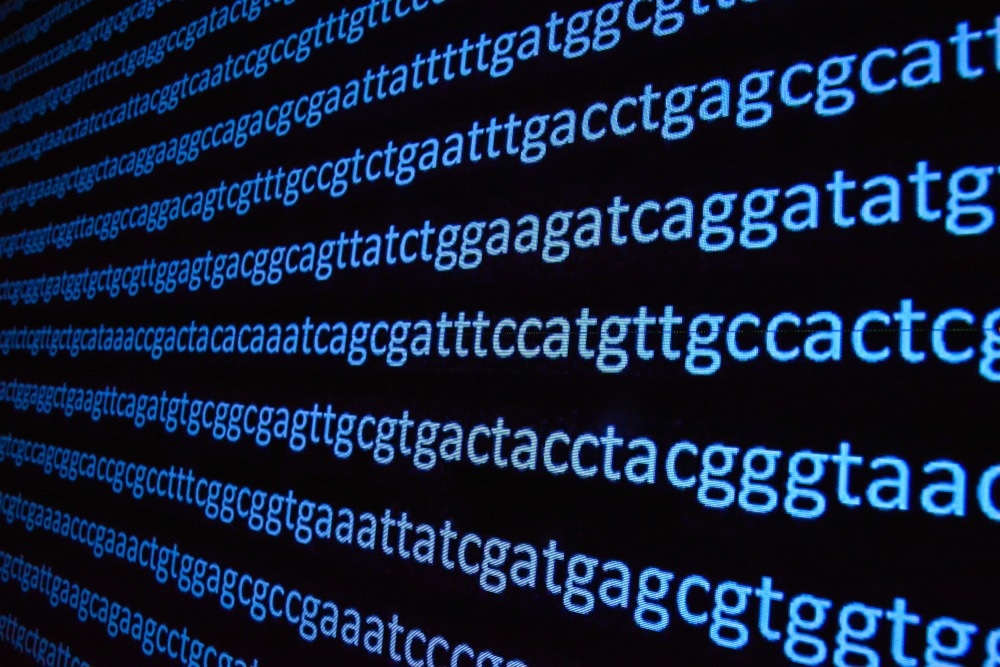The generation of a consensus sequence is a fundamental previous task in many bioinformatic analyses, and it involves the obtention of a single nucleotide sequence (DNA/RNA) or amino acid sequence (protein) that represents aligned and related sequences. This type of bioinformatic sequence-based analysis can give us useful information about the evolutionary history of an organism, the approximate age of a sequence family (e.g., a family of transposons), unique variants in each nucleotide/amino acid position, identification of splicing sites (pre-mRNA), etc.

Image Credit: Wichy/Shutterstock.com
Consensus sequences allow us to make comparative studies and determine the most likely genetic variants not only at the molecular level but also within populations, species, or major taxonomic groups.
What is a Consensus Sequence?
A consensus sequence is a sequence that represents a group of similar sequences shared by two or more biological entities, which a multiple-sequence alignment can evidence. Consensus sequence analysis is generally based on visual inspection to identify the most frequent biopolymer's building blocks at each position, i.e., nucleotides for nucleic acids or amino acids for proteins.
Bioinformatics is a subdiscipline of biology and computing aimed at interpreting biological data using computational tools. Molecular data derived from consensus sequences represent an essential input for bioinformatic analyses because this information can be used to understand and model diverse biological phenomena such as, for example, inferring a phylogenetic tree to determine the evolutionary relationships between a group of species, predicting the function of a target sequence (e.g., a Transcription Factor-binding motif within a promoter region), etc.
In a protein sequence alignment, linear motifs and structural domains can be represented by short and long consensus sequences, respectively. Protein consensus sequences may rescue intrinsic functional characteristics within a related group of proteins, such as, for example, the ability of different proteins to bind multiple partners.
On the other hand, nucleotide consensus sequences can be used to identify single base substitutions capable of altering a phenotype, thereby also giving useful insights into the type and distribution of alleles within a population.
Consensus Sequences and their Functional Importance in Bioinformatics
Consensus sequences derived from a sequence alignment are a fundamental issue in bioinformatics because they represent the first step for comparative analyses. The generation of consensus sequences may be key to identifying molecular mechanisms associated with RNA processing (e.g., alternative splicing), obtaining accurate mRNA sequences from expressed sequence tags (ESTs), finding differences among paralog sequences, removing spurious single nucleotide polymorphisms (SNPs) associated with errors during alignment and/or sequencing, etc.
For example, the TATA box (also called the Goldberg–Hogness box) is a well-known consensus promoter sequence that indicates the initiation of transcription of genes both in Archaea and Eukaryotes. The consensus TATA box sequence is defined by the nucleotide sequence TATAWAW, where W represents either Adenine (A) or Thymine (T).
Visualizing Consensus Sequences
A widely used technique to visualize consensus sequences is sequence logos, which can depict both consensus sequences and sequence diversity. Sequence logos represent a visually appealing way to graphically represent consensus sequences where the letter size is directly proportional to the frequency of a particular nucleotide/amino acid at a specific position in the alignment.
For example, in a DNA alignment that exhibits the results as follows for a nucleotide position: 80% Adenine, 15% Cytosine, 5% Thymine, and 5% Guanine, the most frequent nucleotide in the sequence is denoted by A (Adenine), and therefore we use an augmented A letter to denote this nucleotide.
Consensus sequences vs. Sequence Patterns
Although often related terms, consensus sequences and sequence patterns are different. A consensus sequence can be defined as a single useful sequence capable of representing the linear order of nucleotides or amino acids for a given family of sequences.
Conversely, a sequence pattern is an evolutionarily conserved sequence that may indicate a hidden functional property relative to such sequences. For example, a nucleotide binding site, i.e., a genomic region where a transcription factor binds to initiate transcription, may be locally represented by a consensus sequence, but single base differences can irreversibly alter the binding site topology at the original sequences, and therefore we can only rescue functionality through conserved patterns. Some of the latest bioinformatic methods are based on algorithms that have the dual potential to determine the presence of consensus sequences as well as identify conserved sequence patterns.

Image Credit: Sergei Drozd/Shutterstock.com
The Future of Consensus Sequences in Bioinformatics
Over the last few years, more accurate and faster algorithms to identify sequence patterns and consensus sequences have been developed, which has been essential for understanding biological phenomena at a molecular level. The development of bioinformatic tools has greatly enhanced our ability to recover useful data without working on the wet lab bench.
Canonical consensus sequences may provide valuable insights into the evolution of a given DNA fragment, functional features of protein domains, the discovery of new motifs, etc., at the same time that conserved patterns provide empirical evidence of such properties.
Nonetheless, it is also important to highlight that consensus sequences still raise important limitations (e.g., the exact weight we assign for different nucleotide variants or single gaps). Emerging new and more powerful bioinformatic algorithms will be critical for unraveling these constraints.
Continue Reading: Gene Identification Tools in Bioinformatics
Sources:
- Dogan, Senol, Emrulla Spahiu, and Anis Cilic. "Structural Analysis of microRNAs in Myeloid Cancer Reveals Consensus Motifs." Genes 13.7 (2022): 1152. DOI: https://doi.org/10.3390/genes13071152
- Lee, Christopher. "Generating consensus sequences from partial order multiple sequence alignment graphs." Bioinformatics 19.8 (2003): 999-1008. DOI: https://doi.org/10.1093/bioinformatics/btg109
- Sternke, Matt, Katherine W. Tripp, and Doug Barrick. "The use of consensus sequence information to engineer stability and activity in proteins." Methods in enzymology. Vol. 643. Academic Press, 2020. 149-179. DOI: https://doi.org/10.1016/bs.mie.2020.06.001
- Tareen, Ammar, and Justin B. Kinney. "Logomaker: beautiful sequence logos in Python." Bioinformatics 36.7 (2020): 2272-2274. DOI: https://doi.org/10.1093/bioinformatics/btz921
- Vierstraete, Andy R., and Bart P. Braeckman. "Amplicon_sorter: A tool for reference‐free amplicon sorting based on sequence similarity and for building consensus sequences." Ecology and Evolution 12.3 (2022): e8603. DOI: https://doi.org/10.1002/ece3.8603
Further Reading